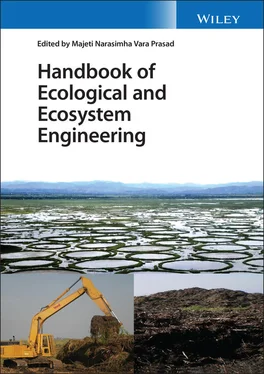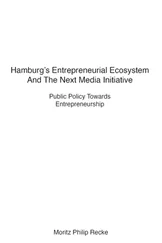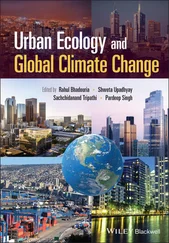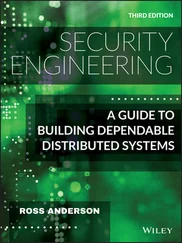Source: Bender, S.F., Wagg, C., and van der Heijden, M.G.A. (2016). “An underground revolution: biodiversity and soil ecological engineering for agricultural sustainability.” Trends in Ecology & Evolution 31 (6): 440–452. © 2016, Elsevier.
The contribution of ecological engineering in designing, building, and operating a new ecosystem is noteworthy. The approach of ecological engineering designs is not as simple as it appears since such designs are proposed to apply to species that are known to evolve within a newly created ecosystem. Although new ecosystems are called by various names such as domestic ecosystems , interface ecosystems , and living machines , they are ultimately the outcome of creative designs incorporated with self‐organized properties of the systems themselves. This approach brings about the selection of species naturally within the framework of ecological engineering designs reflecting the manmade designs through the response of natural choices. This feature makes this field a unique and intellectually motivating branch of applied engineering.
With the aim of solving environmental problems, ecological engineering addresses a subset of issues that have been created anthropogenically and then must be resolved by ecological designs. Among these designs, pollution control or treatment is the most frequent in all environmental areas, where polluted materials are considered resources. The designs are formulated in such a way that pollutants are either stabilized or broken down into useful by‐products with the natural development of the ecosystem, thereby converting the problems into solutions for the successful implementation of ecological engineering principles.
In this chapter, we have discussed hard, soft, and hybrid approaches for improving new or existing infrastructure with modern, complex building models. The primary principles of ecological engineering proposed by Ma [28] were designed to formulate species symbiosis, cycling, and regeneration and harmonize the ecological structure with its function. Later, 12 commandants or guidelines were formulated as principles of ecological engineering. Based on these basic principles, rules of ecotechnology can be derived for proper management of the environment and ecosystem.
The terms ecological engineering and ecotechnology are used interchangeably, although the former defines the creation and restoration of ecosystem while the later describes ecosystem management. Nature represents a self‐organizing, self‐sustaining system up to an exploitation threshold. Thus, any new approach must include a scheme to minimize external influence and also fulfill societal demands. A balance between the natural ecosystem and ecosystem engineering services must be achieved for the vitality of mankind. However, it is vital to identify key conservation priorities and carefully design ecological engineering services with ecological principles and rules to develop and manage structures that effectively enhance industrialization with a reduced impact on the environment.
This chapter discussed in great detail some of the major areas those require the attention of ecological engineering projects for development and restoration. For instance, we have explained coastal development and restoration and proposed ways that ecological engineering could be applied productively to improve the ecological benefits of infrastructure and natural habitat for corals and fishes and also encourage sustainability with the growth of urbanization. A common ecological engineering approach adopted for successful restoration of mangroves practices analytical thought processes with minimum exploitation of the mangrove ecosystem. Various nonstructural measurements are applied in the development of flood hazard plans, including locally grown flood‐fighting crops that help with risk management as well as controlled river engineering by ecological restoration. Likewise, we can rely more on internal regulatory methods rather than traditional agricultural practices.
Soil ecology restoration is the next step toward attaining an overall sustainable agricultural ecosystem. One of the major challenges in the near future is sustaining the human population while maintaining the integrity of the environment. Earth is a closed system, and thus it will be wise to apply human potential toward achieving this goal. Therefore, the expansion of restoration projects in terms of expectations and goals must be realized to achieve all the plausible ecological aspects. Ecological restoration and management should make both explicit and implicit efforts to predict and recommend the ecological future of a location. These attempts need to be extrapolated beyond the prediction within the boundary of scientific limitations during the implementation of ecological restoration and management projects.
1 1 Bebianno, M.J., Pereira, C.G., Rey, F. et al. (2015). Integrated approach to assess ecosystem health in harbor areas. Sci. Total Environ. 514: 92–107.
2 2 Bergen, S.D., Bolton, S.M., and Fridley, J.L. (2001). Design principles for ecological engineering. Ecol. Eng. 18: 201–210.
3 3 Biswas, S.R., Mallik, A.U., Choudhury, J.K., and Nishat, A. (2009). A unified framework for the restoration of Southeast Asian mangroves – bridging ecology, society and economics. Wetlands Ecol. Manage. 17: 365–383.
4 4 Blasco, F., Aizpuru, M., and Gers, C. (2001). Depletion of the mangroves of continental Asia. Wetlands Ecol. Manage. 9 (3): 245–256.
5 5 Bloom, D.E. and Bloom, D.E. (2011). 7 Billion and counting. Science 333: 562–569.
6 6 Brander, L., Brouwer, R., and Wagtendonk, A. (2013). Economic valuation of regulating services provided by wetlands in agricultural landscapes: a meta‐analysis. Ecol. Eng. 56: 89–96.
7 7 Brown, A.C. and McLachlan, A. (2002). Sandy shore ecosystems and the threats facing them: some predictions for the year 2025. Environ. Conserv. 29: 62–77.
8 8 Burt, J.A. and Bartholomew, A. (2019). Towards more sustainable coastal development in the Arabian Gulf: opportunities for ecological engineering in an urbanized seascape. Mar. Pollut. Bull. 142: 93–102.
9 9 Caeiro, S., Vaz‐Fernandes, P., Martinho, A.P. et al. (2017). Environmental risk assessment in a contaminated estuary: an integrated weight of evidence approach as a decision support tool. Ocean Coast. Manage. 143: 51–62.
10 10 Chapman, M.G. and Underwood, A.J. (2011). Evaluation of ecological engineering of “armoured” shorelines to improve their value as habitat. J. Exp. Mar. Biol. Ecol. 400: 302–313.
11 11 Costanza, R., Mitsch, W.J., and Day, J.W. (2006). A new vision for New Orleans and the Mississippi delta: applying ecological economics and ecological engineering. Front. Ecol. Environ. 4: 465–472.
12 12 Day, J.W. Jr., Hall, C.A.S., Yánez‐Arancibia, A. et al. (2009). Ecology in times of scarcity. BioScience 59: 321–331.
13 13 Day, J.W., Psuty, N.P., and Perez, B.C. (2000). The role of pulsing events in the functioning of coastal barriers and wetlands: implications for human impact, management and the response to sea level rise. In: Concepts and Controversies in Salt Marsh Ecology (eds. M.P. Weinstein and D. Dreeger), 633–659. Dordrecht, The Netherlands: Kluwer Academic Publishers.
14 14 Donohue, I., Petchey, O.L., Montoya, J.M. et al. (2013). On the dimensionality of ecological stability. Ecol. Lett. 16 (4): 421.
15 15 Ferrati, R., Canziani, G.A., and Moreno, D.R. (2005). Estero del Ibera: hydrometeorological and hydrological characterization. Ecol. Model. 186: 3–15.
16 16 Food and Agricultural Organization (FAO).(2003). New global mangrove estimate.
17 17 Fu‐liu, X. and Shu, T. (2000). Conceptual understandings of the ecological engineering issues in China and Abroad. J. Environ. Sci. 12: 203–208.
Читать дальше












